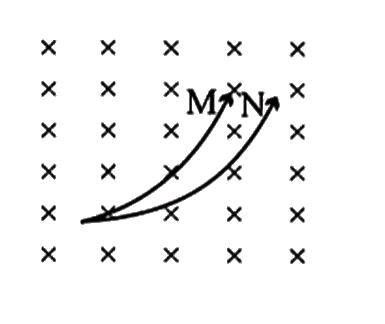Two ions have equal masses but one is singly- ionized and the other is doubly- ionized. They are pojected from the same place in a uniform magnetic field with the same velocity perpendicular to the field.
To solve the problem, we need to analyze the motion of two ions in a uniform magnetic field. The ions have the same mass but different charges due to their ionization states. Let's denote the following:
- Mass of both ions: m
- Velocity of both ions: v
- Magnetic field strength: B
- Charge of the singly ionized ion: q
- Charge of the doubly ionized ion: 2q
1. Understanding the Forces:
When a charged particle moves in a magnetic field, it experiences a magnetic force that acts as the centripetal force required to keep it moving in a circular path. The magnetic force FB is given by:
FB=qvB
The centripetal force FC required to keep the particle in circular motion is given by:
FC=mv2R
where R is the radius of the circular path.
2. Setting Forces Equal:
For the ions to move in a circular path, the magnetic force must equal the centripetal force:
qvB=mv2R
3. Rearranging for Radius:
Rearranging the equation to solve for the radius R:
R=mvqB
4. Calculating the Radius for Each Ion:
- For the singly ionized ion (charge q):
R1=mvqB
- For the doubly ionized ion (charge 2q):
R2=mv2qB
5. Comparing the Radii:
From the equations for R1 and R2, we can see that:
R2=12R1
This indicates that the radius of the path of the doubly ionized ion is half that of the singly ionized ion.
Conclusion:
The radius of the circular path for the singly ionized ion is twice that of the doubly ionized ion. Thus, the singly ionized ion will travel in a larger circle compared to the doubly ionized ion when projected in the same magnetic field with the same velocity.
- Velocity of both ions: v
- Magnetic field strength: B
- Charge of the singly ionized ion: q
- Charge of the doubly ionized ion: 2q
When a charged particle moves in a magnetic field, it experiences a magnetic force that acts as the centripetal force required to keep it moving in a circular path. The magnetic force FB is given by:
FB=qvB
The centripetal force FC required to keep the particle in circular motion is given by:
FC=mv2R
where R is the radius of the circular path.
For the ions to move in a circular path, the magnetic force must equal the centripetal force:
qvB=mv2R
Rearranging the equation to solve for the radius R:
R=mvqB
- For the singly ionized ion (charge q):
R1=mvqB
- For the doubly ionized ion (charge 2q):
R2=mv2qB
From the equations for R1 and R2, we can see that:
R2=12R1
This indicates that the radius of the path of the doubly ionized ion is half that of the singly ionized ion.
The radius of the circular path for the singly ionized ion is twice that of the doubly ionized ion. Thus, the singly ionized ion will travel in a larger circle compared to the doubly ionized ion when projected in the same magnetic field with the same velocity.
Topper's Solved these Questions
- MAGNETIC FIELDBOOK - HC VERMA ENGLISHCHAPTER - MAGNETIC FIELDEXERCISE - QUESTIONS FOR SHORT ASNWER
10 Videos
- LIGHT WAVESBOOK - HC VERMA ENGLISHCHAPTER - LIGHT WAVESEXERCISE - Question for short Answer
11 Videos
- MAGNETIC FIELD DUE TO CURRENTBOOK - HC VERMA ENGLISHCHAPTER - MAGNETIC FIELD DUE TO CURRENTEXERCISE - questions for short answer
12 Videos
Similar Questions
Knowledge Check
A conducting ring is placed in a uniform magnetic field with its plane perpendicular to the field . An emf is induced in the ring if
Ait is rotated about its axis.Bit is rotated about its diameter.Cit is not moved.Dit is given translational motion in the field.
The pair of particles which have same acceleration in a uniform electric field is
View SolutionA proton and an alpha particle projected with same velocity in uniform transverse magnetic field then
View SolutionA proton and anα-particles enters in a uniform magnetic field with same velocity, then ratio of the radii of path describe by them
View SolutionWhich of the following particles will describe the smallest circle when projected with the same velocity perpendicular to a magnetic field?
View SolutionWhich of the follwing particles will have minimum frequency of revolution when projected with the same velocity perpendicular to a magnetic field?
View SolutionWhich of the follwing particles will have minimum frequency of revolution when projected with the same velocity perpendicular to a magnetic field?
View SolutionTwo identical coils, one of copper and the other of iron, are rotated with the same angular velocity ω in a uniform magnetic field. In which case the induced e.m.f. is more and why?
View Solution

